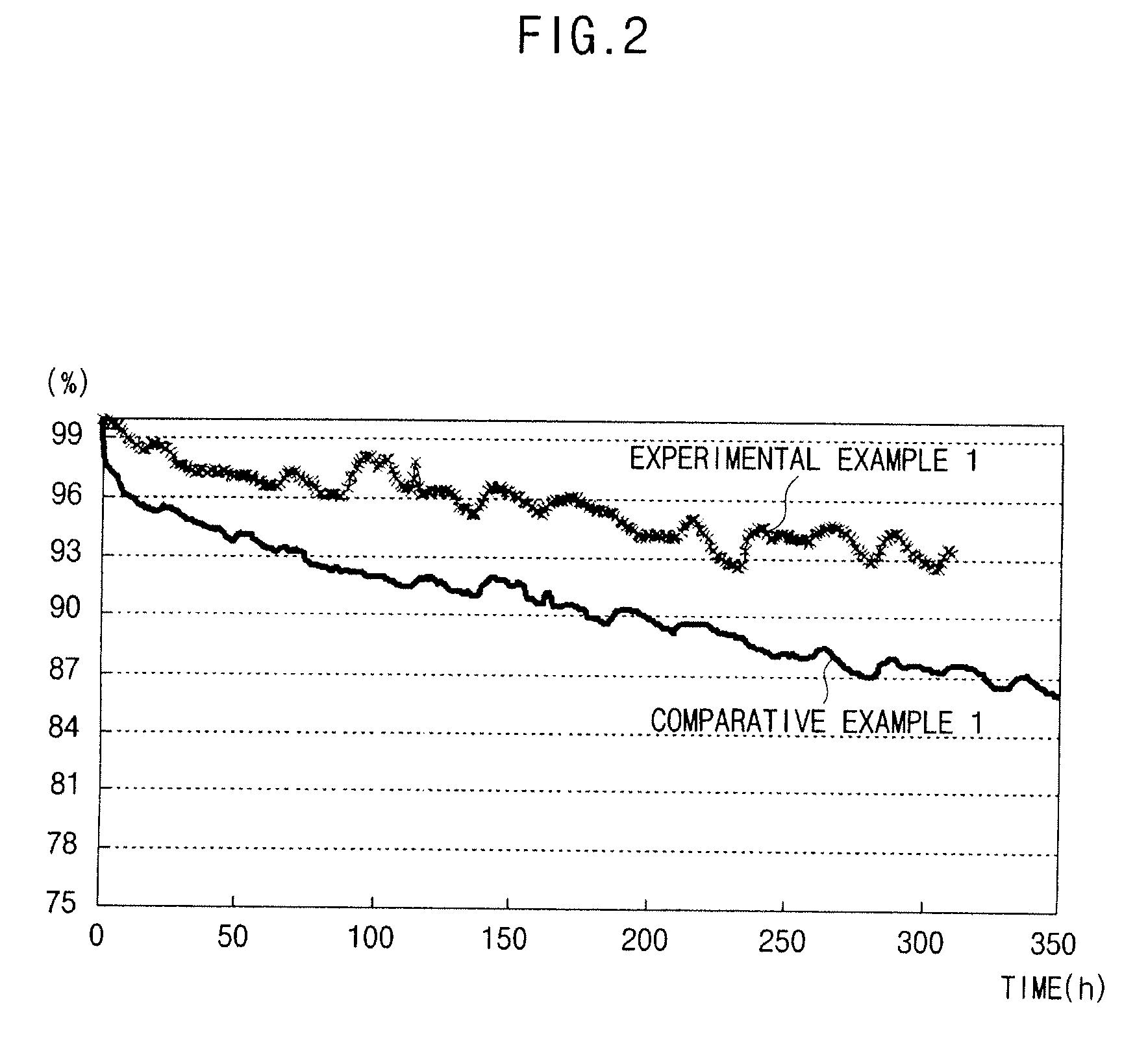Organic light emitting diode and method of manufacturing the same
a light-emitting diode and organic technology, applied in the direction of discharge tube/lamp details, discharge tube luminescnet screens, organic chemistry, etc., can solve the problems of poor luminous efficiency, insufficient lifespan, difficult to achieve high-quality oleds, etc., to increase luminous efficiency and lifespan, reduce driving voltage and current consumption
- Summary
- Abstract
- Description
- Claims
- Application Information
AI Technical Summary
Benefits of technology
Problems solved by technology
Method used
Image
Examples
experimental example 1
[0039]A first electrode was formed of ITO to a thickness of about 130 nm. Thereafter, an HIL was formed of IDE-406 (obtained from Idemitsu Co.) on the first electrode to a thickness of about 210 nm, and an HTL was formed of NPB to a thickness of about 20 nm. A red EML was formed on the HTL to a thickness of about 40 nm using a mixture of CBP as a host and 15% by weight Ir(piq)3 as a dopant. An ETL was formed on the red EML. Specifically, 50% by weight of lithium quinolate as an organic metal complex containing an alkali metal, and 50% by weight of a compound of Formula 1 were co-deposited to a thickness of about 30 nm. In the compound of Formula 1, R9 is a phenyl group to which a benzimidazolyl group is bonded, and each of R1 to R8 and R10 to R22 is hydrogen. Subsequently, a second electrode was formed on the ETL. To form the second electrode, an MgAg layer was formed to a thickness of about 16 nm, and an Al layer was formed on the MgAg layer to a thickness of about 100 nm.
experimental example 2
[0044]A first electrode was formed of ITO to a thickness of about 130 nm. Thereafter, an HIL was formed of IDE-406 (obtained from Idemitsu Co.) on the first electrode to a thickness of about 210 nm, and an HTL was formed of NPB to a thickness of about 20 nm. A red EML was formed on the HTL to a thickness of about 30 nm using a mixture of CBP as a host and 8% by weight lr(piq)3 as a dopant. An ETL was formed on the red EML. Specifically, 25% by weight of sodium quinolate (which is an organic metal complex containing an alkali metal) and 75% by weight of a compound of Formula 1 were co-deposited to a thickness of about 30 nm. In the compound of Formula 1, R9 is a phenyl group to which a benzimidazolyl group is bonded, and each of R1 to R8 and R10 to R22 is hydrogen.
[0045]Subsequently, a second electrode was formed on the ETL. To form the second electrode, an MgAg layer was formed to a thickness of about 16 nm, and an Al layer was formed on the MgAg layer to a thickness of about 100 nm...
experimental example 3
[0049]A first electrode was formed of ITO to a thickness of about 130 nm. Thereafter, an HIL was formed of IDE-406 (obtained from Idemitsu Co.) on the first electrode to a thickness of about 210 nm, and an HTL was formed of NPB to a thickness of about 20 nm. A red EML was formed on the HTL to a thickness of about 30 nm using a mixture of CBP as a host and 8% by weight lr(piq)3 as a dopant. An ETL was formed on the red EML. Specifically, 50% by weight of sodium quinolate (which is an organic metal complex containing an alkali metal) and 50% by weight of a compound of Formula 1 were co-deposited to a thickness of about 30 nm. In the compound of Formula 1, R9 is a phenyl group to which a benzimidazolyl group is bonded, and each of R1 to R8 and R10 to R22 is hydrogen.
[0050]Subsequently, a second electrode was formed on the ETL. To form the second electrode, an MgAg layer was formed to a thickness of about 16 nm, and an Al layer was formed on the MgAg layer to a thickness of about 100 nm...
PUM
| Property | Measurement | Unit |
|---|---|---|
| thickness | aaaaa | aaaaa |
| thickness | aaaaa | aaaaa |
| thickness | aaaaa | aaaaa |
Abstract
Description
Claims
Application Information
 Login to View More
Login to View More - R&D
- Intellectual Property
- Life Sciences
- Materials
- Tech Scout
- Unparalleled Data Quality
- Higher Quality Content
- 60% Fewer Hallucinations
Browse by: Latest US Patents, China's latest patents, Technical Efficacy Thesaurus, Application Domain, Technology Topic, Popular Technical Reports.
© 2025 PatSnap. All rights reserved.Legal|Privacy policy|Modern Slavery Act Transparency Statement|Sitemap|About US| Contact US: help@patsnap.com



